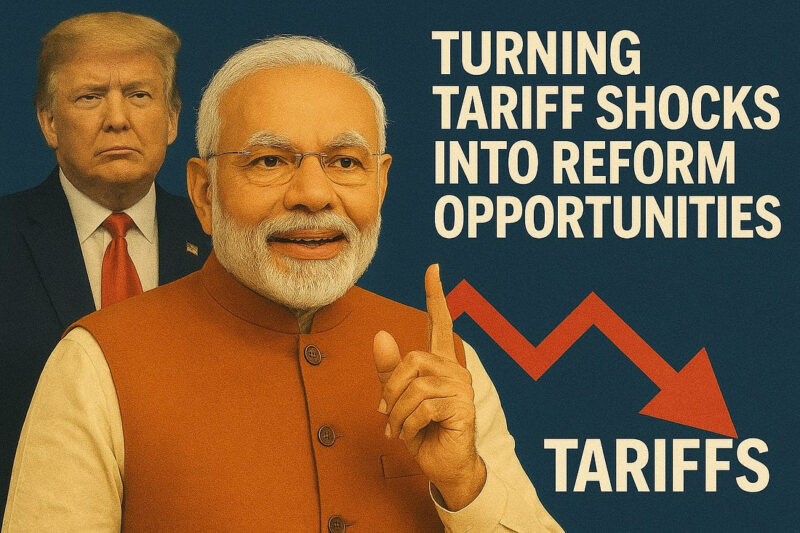 India has bright spots: UPI powers billions of transactions each month, our pharma industry supplies low-cost medicines to 200 nations, and Chandrayaan has shown world-class science on modest budgets. But these successes coexist with deep structural weaknesses—bureaucratic hurdles, painfully slow courts, outdated farm laws, rigid labor codes, and messy land rules. When tariffs add 10–50% costs on exports like textiles, steel, or IT services, these weaknesses hurt even more. Reform is no longer optional.
India has bright spots: UPI powers billions of transactions each month, our pharma industry supplies low-cost medicines to 200 nations, and Chandrayaan has shown world-class science on modest budgets. But these successes coexist with deep structural weaknesses—bureaucratic hurdles, painfully slow courts, outdated farm laws, rigid labor codes, and messy land rules. When tariffs add 10–50% costs on exports like textiles, steel, or IT services, these weaknesses hurt even more. Reform is no longer optional.
Cutting Red Tape: Make Bureaucracy a Partner
India’s regulatory maze still discourages investment. Endless permits, surprise inspections, and vague rules often translate into corruption. While India’s ranking in ease of doing business has improved, we remain poor at contract enforcement and property registration.
What’s needed is one transparent digital portal where approvals are cleared within 30–60 days. Replace “inspector raj” with AI-driven compliance checks that are quick and fair. Simplify taxes: merge GST into 2–3 slabs, cut income tax rates, and give cheaper loans to small firms. Such clarity can attract \$100 billion more foreign investment annually, making India a true rival to Southeast Asia’s manufacturing hubs.
Without this, tariff shocks will hurt us harder and capital will shift to nimbler economies. Crucially, reform must be institutional—not left to short-term political cycles.
Fixing Courts: Justice at Business Speed
India’s judicial delays are a silent tax on growth. Over 85,000 cases are pending in the Supreme Court, and commercial disputes take more than 1,400 days to resolve—compared to 150 in Singapore. No investor feels secure where contracts can drag for years.
India should set up dedicated commercial courts with a 180-day deadline. Arbitration and specialized tribunals must be expanded. Technology can track cases, while the number of judges—among the lowest per capita globally—must be increased. Quick justice builds confidence as strongly as new highways or airports. In an age of tariffs, fast courts are essential to keep investors anchored in India.
Revamping Agriculture: From Subsidy Trap to Growth Engine

A farmer and keen observer of current affairs
Half of India’s workforce depends on farming, yet it contributes barely 15–20% of GDP. Land ceiling laws limit farm sizes to 5–18 hectares, blocking scale and modern practices. Average plots have shrunk to just over one hectare. Subsidies worth ₹3.7 lakh crore leak by 20–25%, and nearly 40% of food rots in poor storage.
Tariffs on rice and spices will expose these weaknesses further. The answer is bold reform: lift ceilings to enable larger, efficient farms; free cooperatives from political control; invest in cold chains and processing through public-private partnerships; and redirect subsidies into direct cash transfers that support innovation in seeds, biotech, and water-saving methods.
Unshackled, Indian agriculture can move from exporting raw produce to processed foods, doubling farmer incomes by 2030 and powering rural jobs.
Freeing Land and Labor: The Next Leap
Land disputes and outdated titles delay projects and raise costs. Digitizing ownership with blockchain can cut litigation by half. Dedicated land courts would further speed settlement.
On labor, India still carries 40+ fragmented laws. The new labor codes of 2025 are a start but must go further—making hiring and firing simpler while ensuring portable social security, skills training, and safety nets. With flexibility and protection balanced, India could create 10–15 million jobs each year, just when global supply chains are seeking alternatives to China.
Way Forward: Strong Inside, Open Outside
Atmanirbhar Bharat is not about isolation. India built Tejas fighter jets and COVID vaccines under stress, showing resilience. Remember the unbeatable success of Chandrayan. The future lies in strengthening governance, agriculture, land, and labor, while staying open to trade, investment, and ideas. We must back R\&D in chips, clean energy, and biotech to compete globally.
Trump’s tariffs are not the end of India’s rise—they are a signal. The world is turning inward. India’s answer must be to push through reforms long delayed. Bureaucracy must enable, not obstruct; courts must deliver speed, not delay; farms must grow with scale, not subsidies; land and labor must free enterprise, not trap it.
If India seizes this moment, tariffs abroad may bruise us, but resilience at home will make us unstoppable to achieve what we desire to be in 2047.